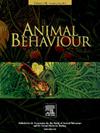Deep learning approach to detect and visualize sexual dimorphism in monomorphic species
IF 2.3
2区 生物学
Q2 BEHAVIORAL SCIENCES
引用次数: 0
Abstract
Sex recognition is facilitated by dimorphism in some traits. However, humans often fail to find the traits that allow distinction between sexes in other species. Deep learning has shown great application potential in identifying cryptic differences between sexes, but it has rarely been used to assess sexual dimorphism. In this study, the ability of a fine-tuned classification neural network, which is known as EfficientNet, to find differences between sexes in a species that appears monomorphic to humans, such as the sociable weaver, Philetairus socius, was evaluated. In addition, the benefits of the Grad-CAM visualization technique were assessed to understand which parts of the head of the individuals are used by the network to differentiate the sexes. We trained 10-fold cross-validation models on more than 4500 pictures of the head from more than 1300 individuals. Results show that the network can predict the sex of sociable weavers with an accuracy of 76%, which is considerably higher than humans' performance (56%). Moreover, the model was similarly good at predicting females and males. When interpreting the probability of being classified to one sex, our results further reveal the effect of the interaction of sex with age on the confidence score of the models, which shows that younger males are less masculine than older ones, and older females are more masculine than younger ones. Finally, using Grad-CAM, we found that the model mostly used the bill region to predict the sex of individuals. Overall, this work shows the potential application of artificial intelligence as a noninvasive sexing tool, surpassing human capabilities and aiding in pinpointing potential cryptic dimorphic body parts that have yet to be identified. Half of the world’s bird species appear sexually monomorphic to humans, and re-evaluation of species dimorphism with this type of methods could deepen our understanding of topics such as sex-specific selection on animal traits, behavioural differences and sex ratio variation across time.
单态物种两性二态性的深度学习检测和可视化方法
某些特征的二态性促进了性别识别。然而,人类经常无法在其他物种中找到允许区分性别的特征。深度学习在识别两性之间的隐性差异方面显示出巨大的应用潜力,但很少用于评估两性二态性。在这项研究中,一个被称为“高效网络”的微调分类神经网络的能力被评估,以发现对人类来说似乎是单态的物种之间的性别差异,比如社会性织布者菲利特拉斯。此外,还评估了Grad-CAM可视化技术的好处,以了解个体头部的哪些部分被神经网络用于区分性别。我们在1300多人的4500多张头部图片上训练了10倍交叉验证模型。结果表明,该网络预测社会性织工性别的准确率为76%,远远高于人类的56%。此外,该模型在预测女性和男性方面同样出色。在解释被分类为某一性别的概率时,我们的结果进一步揭示了性别与年龄的相互作用对模型置信度得分的影响,表明年轻男性比年长男性更男性化,而年长女性比年轻女性更男性化。最后,使用Grad-CAM,我们发现该模型主要使用喙区来预测个体的性别。总的来说,这项工作显示了人工智能作为一种非侵入性的性别工具的潜在应用,超越了人类的能力,并有助于确定尚未确定的潜在隐性二态身体部位。世界上一半的鸟类对人类来说是单性的,用这种方法重新评估物种二态性可以加深我们对动物特征的性别特异性选择、行为差异和性别比例随时间变化等主题的理解。
本文章由计算机程序翻译,如有差异,请以英文原文为准。
求助全文
约1分钟内获得全文
求助全文
来源期刊

Animal Behaviour
生物-动物学
CiteScore
4.60
自引率
8.00%
发文量
236
审稿时长
10.2 weeks
期刊介绍:
Growing interest in behavioural biology and the international reputation of Animal Behaviour prompted an expansion to monthly publication in 1989. Animal Behaviour continues to be the journal of choice for biologists, ethologists, psychologists, physiologists, and veterinarians with an interest in the subject.
 求助内容:
求助内容: 应助结果提醒方式:
应助结果提醒方式:


